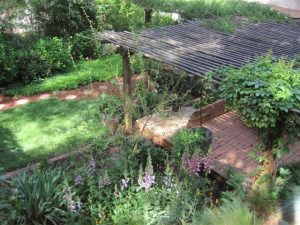Douglas Tallamy, entomology professor at the University of Delaware, in his book “Bringing Nature Home” develops his philosophy that—with the degradation of wild habitat by humans—we can recreate habitat in our own backyards to support wildlife. By creating a string of tiny habitats linked together (your yard to your neighbors, etc.) we can recreate viable habitat corridors for species we have displaced.
His advice: the one most important thing you can do to support wildlife is to plant a native oak. Our native oaks can be hundreds of years old and are a wildlife bonanza providing acorns, insects, cover and nesting spots. Oak trees support at least 313 species of vertebrates (animals with backbones), including mammals, birds, reptiles and amphibians. They also host an estimated minimum 5000 species of insects and more species of Lepidoptera (moths and butterflies) than any other plant! For more information about the value and care of oaks, go to UC’s Oak Woodland Management web page at http://ucanr.edu/sites/oak_range/
To keep your oaks healthy, measure from the trunk to the edge of the dripline (where the shadow of the leaves falls when the sun is directly overhead). Add half that measurement again to the width of the dripline. This is the Tree Protection Zone (TPZ) or root protection zone. Do not cut the roots or trench within this area. Don’t add or remove soil or change the slope. Do not water or plant within this area.
In addition to planting a native oak tree, there are several other necessities you can provide to encourage wildlife to visit your property:
- Water is one of the most important, especially in our hot and dry foothills. A pond or birdbath attracts an amazing variety of birds; pans of water on the ground also help frogs, lizards and toads through the dry stretch.
- Places to live include places to hide and to raise young. A layer of mulch, trees, shrubs, old tree snags, ponds, brush piles, bird and bat houses and open ground are all home to some sort of wildlife.
- Plants native to the area provide more food and cover for animals than lawns do. Landscape with plants native to our area; many are drought and deer tolerant. Look for plants that provide seeds and berries, as well as nectar and pollen-producing flowers for bees and other pollinators.
- Reduce pesticide use. A yard safe for wildlife is a yard with little or no pesticides. For more information about gardening to support wildlife, please visit the National Wildlife Federation website at: http://www.nwf.org/Garden-For-Wildlife.aspx
Insects are part of the complex web of interactions that support a host of other species, especially songbirds. Manage any damage-causing pests responsibly. The University of California Integrated Pest Management program (IPM) offers information to help you reduce the kinds and amount of pesticides. IPM is the practice of using less toxic techniques to control pests and diseases. Visit the Integrated Pest Management website (www.ipm.ucdavis.edu) to learn more.
If you need help identifying that insect living in your yard, there is an excellent website hosted by Iowa State University that offers silhouettes of common insects to help your identification sleuthing. The web address is: http://bugguide.net/
For more information about foothill-friendly gardening and for answers to specific gardening questions, please call the UCCE Master Gardeners of Tuolumne hot line at (209)-533-5912 or email; mgtuolumne@ucanr.edu.
Rebecca Miller-Cripps is a University of California Cooperative Extension Master Gardener of Tuolumne County.


